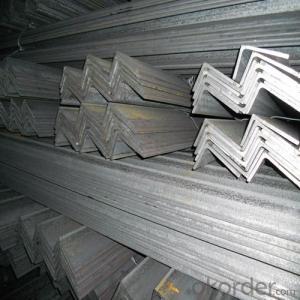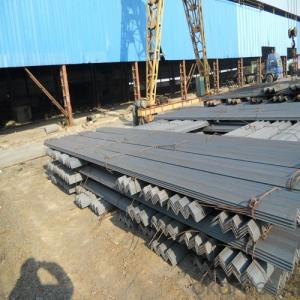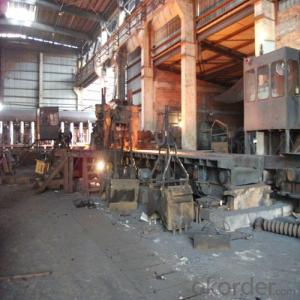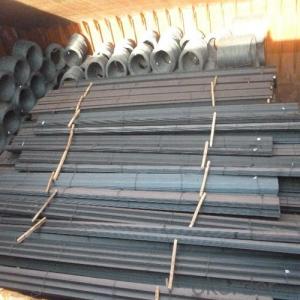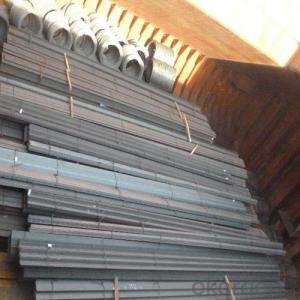Hot Rolled Angle Bar Steel 6M or 12M EN10025,JIS G3192,DIN 1026,GB 707-88
- Loading Port:
- Tianjin
- Payment Terms:
- TT or LC
- Min Order Qty:
- 100 m.t.
- Supply Capability:
- 20000 m.t./month
OKorder Service Pledge
OKorder Financial Service
You Might Also Like
Product Description:
Specifications of Angle Steel
1. Invoicing on theoretical weight or actual weight as customer request
2. Length: 6m, 9m, 12m as following table
3. Sizes

Sizes: 25mm-250mm | ||
a*t | ||
25*2.5-4.0 | 70*6.0-9.0 | 130*9.0-15 |
30*2.5-6.6 | 75*6.0-9.0 | 140*10-14 |
36*3.0-5.0 | 80*5.0-10 | 150*10-20 |
38*2.3-6.0 | 90*7.0-10 | 160*10-16 |
40*3.0-5.0 | 100*6.0-12 | 175*12-15 |
45*4.0-6.0 | 110*8.0-10 | 180*12-18 |
50*4.0-6.0 | 120*6.0-15 | 200*14-25 |
60*4.0-8.0 | 125*8.0-14 | 250*25 |
5. Payment terms:
1).100% irrevocable L/C at sight.
2).30% T/T prepaid and the balance against the copy of B/L.
3).30% T/T prepaid and the balance against L/C
6.Material details:
Alloy No | Grade | Element (%) | |||||
C | Mn | S | P | Si | |||
Q235 | B | 0.12—0.20 | 0.3—0.7 | ≤0.045 | ≤0.045 | ≤0.3 | |
Alloy No | Grade | Yielding strength point( Mpa) | |||||
Thickness (mm) | |||||||
≤16 | >16--40 | >40--60 | >60--100 | ||||
≥ | |||||||
Q235 | B | 235 | 225 | 215 | 205 | ||
Alloy No | Grade | Tensile strength (Mpa) | Elongation after fracture (%) | ||||
Thickness (mm) | |||||||
≤16 | >16--40 | >40--60 | >60--100 | ||||
≥ | |||||||
Q235 | B | 375--500 | 26 | 25 | 24 | 23 | |
Usage & Applications of Angle Steel
According to the needs of different structures, Angle can compose to different force support component, and also can be the connections between components. It is widely used in various building structures and engineering structures such as roof beams, bridges, transmission towers, hoisting machinery and transport machinery, ships, industrial furnaces, reaction tower, container frame and warehouse etc.
Packaging & Delivery of Structure Steel Angle Bar
1. Transportation: the goods are delivered by truck from mill to loading port, the maximum quantity can be loaded is around 40MTs by each truck. If the order quantity cannot reach the full truck loaded, the transportation cost per ton will be little higher than full load.
2. With bundles and load in 20 feet/40 feet container, or by bulk cargo, also we could do as customer's request.
3. Marks:
Color mark: There will be color marking on both end of the bundle for the cargo delivered by bulk vessel. That makes it easily to distinguish at the destination port.
Tag mark: There will be tag mark tied up on the bundles. The information usually including supplier logo and name, product name, made in China, shipping marks and other information request by the customer.
If loading by container the marking is not needed, but we will prepare it as customer request.
The angle is perpendicular to each other on both sides of the steel strip into the corner. There are equilateral angle steel and unequal angle points. An equal angle two edge width equal.
The angle is built with carbon steel, is a simple section steel steel, mainly used for metal components and the frame of the plant. In the use of the requirements are good, plastic deformation properties and a certain mechanical strength. The production of raw materials for low carbon steel billet steel billets, finished angle for the hot rolling, normalizing or hot-rolled state of delivery.
The specifications are expressed by the MM number of edges and sides and the thickness of the thick. Such as "/ 30 x 30 x 3", that is 30 mm equilateral angle edge width edge thickness was 3 mm. Also available models that model is the number of centimeters wide, such as angle 3#. Model doesn't mean thickness angle of different size in the same model, thus in the edge of the contracts and other documents will be angle width, edge thick size fill in complete, avoid separate model, said. The specifications for 2#-20# hot rolled equilateral angle steel.
The surface quality of the equilateral angle steel are specified in the standard and may not generally require the use of harmful defects, such as delamination, scarring, and cracks. Equilateral angle geometry error allowed range in the standard also provides, in general, including bending, edge width, edge thickness, dip angle and theoretical weight, and provides significant torsional angle not.
Angle according to the different needs of structure composed of a variety of stress components, can also be used as a component of the connections between the. Angle steel is mainly used for manufacturing the frame structure, such as high voltage transmission tower, steel structure bridge girder on both sides of the framework, tower crane of the column and arm lever on the construction site, workshop of column and beam, small place such as festivals roadside put pot in the shape of a shelf, in window hanging solar air conditioning such as shelves.
- Q:What are the typical uses for steel angles?
- Steel angles have a wide range of uses in various industries and construction projects. One of the most common applications is in structural framing, where steel angles are used to provide additional strength and support to buildings and other structures. They are often used to create bracing, reinforcing, and framing elements in construction projects, such as beams, columns, and trusses. Another typical use for steel angles is in manufacturing and fabrication. They are utilized in the production of machinery, equipment, and vehicles, where their ability to withstand heavy loads and resist bending or warping makes them an ideal choice. Steel angles can be used as frames, supports, or brackets in the construction of various industrial equipment and machinery. Steel angles are also commonly used in the manufacturing of furniture, especially in metalwork and carpentry. They can be used as corner brackets or connectors to provide stability and strength to furniture pieces like tables, chairs, and shelves. Additionally, steel angles are often used in the construction of storage racks and shelving systems, as they offer durability and stability for holding heavy loads. In the transportation industry, steel angles are frequently used in the manufacturing of trailers, truck beds, and frames for various vehicles. Their high strength and resistance to impact and vibrations make them suitable for these applications, ensuring the structural integrity and longevity of the vehicles. Overall, the typical uses for steel angles span across a wide range of industries and applications. Their versatility, strength, and durability make them a popular choice for structural support, manufacturing, furniture construction, and various other projects where robustness and stability are required.
- Q:Are steel angles suitable for use in high-rise buildings?
- Yes, steel angles are suitable for use in high-rise buildings. They are commonly used as structural members in high-rise construction due to their strength, durability, and ability to withstand heavy loads and forces. Steel angles provide excellent support and stability, making them a reliable choice for constructing the framework of high-rise buildings.
- Q:Can steel angles be used for fencing or security applications?
- Yes, steel angles can be used for fencing or security applications. Steel angles are commonly used in construction and are known for their strength and durability. When used for fencing, steel angles can provide a sturdy framework that can withstand harsh weather conditions and potential impacts. They can be welded or bolted together to create a secure and robust fence structure. Additionally, steel angles can also be used for security applications such as gates, barriers, and grills. The strength of steel angles makes them an ideal choice for enhancing security and ensuring the protection of a property.
- Q:How do you calculate the buckling strength of a steel angle?
- To calculate the buckling strength of a steel angle, several factors need to be considered. The buckling strength refers to the ability of the angle to resist buckling or collapse under applied loads. Firstly, the geometry of the steel angle must be determined. This includes the dimensions of the angle, such as the length of the legs and the thickness of the steel. Additionally, the cross-sectional properties, such as the moment of inertia and the section modulus, need to be calculated. Next, the effective length of the angle needs to be determined. The effective length is a measure of how restrained the angle is against buckling. It depends on factors such as the boundary conditions and the connection details. The effective length can be different for different modes of buckling, such as flexural or torsional buckling. Once the effective length is determined, the critical buckling load can be calculated using an appropriate buckling equation. There are several buckling equations available, depending on the boundary conditions and the mode of buckling. For example, the Euler buckling equation can be used for long, slender angles subjected to axial compression. Other equations, such as the Johnson buckling equation, may be used for more complex loading scenarios. The critical buckling load can then be converted to an allowable stress using a suitable safety factor. The safety factor accounts for uncertainties in the calculation and ensures that the angle can safely carry the applied load without buckling. The safety factor is typically specified by design codes or industry standards. In summary, calculating the buckling strength of a steel angle involves determining the geometry and effective length of the angle, applying an appropriate buckling equation, and converting the critical load to an allowable stress using a safety factor. It is important to consult relevant design codes and standards to ensure accurate and safe calculations.
- Q:What are the common methods of joining steel angles together?
- There exist various methods for connecting steel angles together. 1. Welding is a well-liked technique employed to join steel angles. This involves the melting of the angle edges, followed by cooling and solidification to establish a robust bond. Welding can be executed using diverse approaches like arc welding, MIG welding, or TIG welding. 2. Bolting is yet another frequent method used for joining steel angles. It entails using bolts, nuts, and washers to secure the angles in place. This technique permits easy dismantling and reassembly, if necessary. Bolts are typically utilized in combination with gusset plates or brackets to provide added strength and stability. 3. Riveting is a conventional method of connecting steel angles. It necessitates the usage of a rivet, a cylindrical metal pin, to hold the angles firmly. The rivet is inserted into pre-drilled holes in the angles and then deformed on one end to create a head, thereby securing the angles together. 4. Adhesive bonding is a technique that utilizes a specialized adhesive to connect steel angles. The adhesive is applied between the angles, and pressure is exerted to ensure a sturdy bond. Adhesive bonding is often employed in situations where a clean and visually appealing joint is desired. 5. Mechanical fasteners, such as screws, nails, or self-tapping screws, can also be employed to join steel angles. These fasteners are inserted into pre-drilled holes to establish a secure connection. However, they may not possess the same level of strength as other methods like welding or bolting. When selecting the appropriate method for joining steel angles, it is crucial to consider the specific requirements of the application, including load-bearing capacity, aesthetics, and ease of disassembly.
- Q:What is angle iron?
- The angle iron can be made up of different force components according to the different structure, and can also be used as the connecting piece between the components. Widely used in a variety of architectural and engineering structures, such as beams, bridges, towers, hoisting and conveying machinery, ships, industrial furnace, reaction tower, container rack and warehouse shelves, also used to protect column, wall parts easy to hit.
- Q:What are the common welding techniques used for steel angles?
- The common welding techniques used for steel angles include shielded metal arc welding (SMAW), gas metal arc welding (GMAW), and flux-cored arc welding (FCAW).
- Q:Do steel angles have a smooth or textured surface?
- Steel angles generally possess a textured exterior, which is formed when the steel is either hot-rolled or cold-formed into the angled shape during the manufacturing process. As a consequence, the steel angles acquire a slightly uneven or knobby surface, enhancing their ability to offer improved grip and stability in diverse applications. Furthermore, this texture serves to deter objects from slipping or sliding when they come into contact with the steel angles. Nevertheless, it should be noted that the degree of texture can differ based on the particular manufacturing technique employed and the intended purpose of the steel angles.
- Q:What are the different types of steel angles used in staircases?
- Staircases commonly employ various types of steel angles for different purposes. These angles are selected based on the specific needs of the staircase design. 1. The Equal Leg Angle, which forms a 90-degree angle with legs of equal length, is the most frequently used steel angle in staircases. It is typically utilized for structural support within the framework of the staircase. 2. Unequal Leg Angles, as the name implies, have legs of varying lengths. These angles are employed when one side of the staircase requires more support or when a desired aesthetic appearance is desired. They are commonly found in stair treads, risers, and stringers to enhance stability and strength. 3. L-Shaped Angles are utilized in corner connections of staircases. They consist of one straight leg and another leg perpendicular to it, forming an L shape. These angles are often used in stair handrails, balusters, and brackets to provide reinforcement and support at junctions. 4. Slotted Angles are designed with slots along their length, allowing for easy adjustment and flexibility in component positioning. They are frequently employed in adjustable stair brackets, tread supports, and other elements that may require fine-tuning during installation. 5. Flat Bar Angles, also referred to as flat stock angles, are created by bending flat steel bars to form a right angle. These angles are used to provide additional support and reinforcement in staircases that require extra strength. They are commonly found in heavy-duty stair applications or where increased load-bearing capacity is necessary. Ultimately, the appropriate choice of steel angle for a staircase depends on factors such as load capacity, structural requirements, aesthetic considerations, and the specific design of the staircase. Seeking guidance from a structural engineer or staircase designer can assist in determining the most suitable type of steel angle for a particular staircase project.
- Q:How do steel angles contribute to sustainable transportation infrastructure?
- There are several ways in which steel angles contribute to sustainable transportation infrastructure. To begin with, steel angles are essential in building bridges and highways. Their strength and durability make them perfect for supporting heavy loads and enduring the harsh conditions that transportation infrastructure faces. Consequently, structures constructed with steel angles have a longer lifespan, reducing the need for frequent repairs or replacements. This not only saves money but also lessens the environmental impact associated with the production and disposal of construction materials. Furthermore, the use of steel angles in the construction of transportation infrastructure allows for more efficient designs. Engineers can create innovative and lightweight structures with the versatility of steel angles, resulting in the requirement of less material overall. This leads to reduced energy consumption during the construction process and decreased emissions during transportation and installation. Moreover, steel angles are recyclable. They can be easily recycled and utilized to manufacture new steel products when they reach the end of their lifespan. This lessens the demand for raw materials and minimizes waste sent to landfills. The recycling process also requires less energy and emits fewer greenhouse gases compared to the production of new steel, making it an environmentally friendly choice. Additionally, steel angles can contribute to sustainable transportation infrastructure by facilitating the integration of sustainable technologies. They can support solar panels or wind turbines, enabling the generation of clean energy to power transportation systems. By incorporating renewable energy sources into infrastructure projects, the reliance on fossil fuels can be reduced, resulting in decreased greenhouse gas emissions and a more sustainable transportation system. In conclusion, steel angles have a crucial role to play in sustainable transportation infrastructure. Their strength, durability, recyclability, and ability to support sustainable technologies make them an environmentally friendly choice. By incorporating steel angles in the construction of bridges, highways, and other transportation structures, we can create a more sustainable and resilient transportation system that reduces the environmental impact and promotes a greener future.
1. Manufacturer Overview |
|
|---|---|
| Location | |
| Year Established | |
| Annual Output Value | |
| Main Markets | |
| Company Certifications | |
2. Manufacturer Certificates |
|
|---|---|
| a) Certification Name | |
| Range | |
| Reference | |
| Validity Period | |
3. Manufacturer Capability |
|
|---|---|
| a)Trade Capacity | |
| Nearest Port | |
| Export Percentage | |
| No.of Employees in Trade Department | |
| Language Spoken: | |
| b)Factory Information | |
| Factory Size: | |
| No. of Production Lines | |
| Contract Manufacturing | |
| Product Price Range | |
Send your message to us
Hot Rolled Angle Bar Steel 6M or 12M EN10025,JIS G3192,DIN 1026,GB 707-88
- Loading Port:
- Tianjin
- Payment Terms:
- TT or LC
- Min Order Qty:
- 100 m.t.
- Supply Capability:
- 20000 m.t./month
OKorder Service Pledge
OKorder Financial Service
Similar products
New products
Hot products
Related keywords
